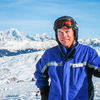Massive B-36 with Tank Tracks
Sep 26, 2014 08:28:54 #
One big plane, and it could land on rough ground by using tank tracks.
Video
http://www.youtube.com/watch?v=eDCgMlomhvM
Video
http://www.youtube.com/watch?v=eDCgMlomhvM
Sep 26, 2014 09:30:11 #
Fascinating. Hope the guy who came up that brainstorm found his way to early retirement. I wonder what the expected life cycle of that system was... 1 or 2 landings.
Sep 27, 2014 07:56:55 #
My Dad worked and flew on these huge planes. One even had a nuclear reactor onboard.
Sep 27, 2014 09:12:30 #
davefales wrote:
Fascinating. Hope the guy who came up that brainstorm found his way to early retirement. I wonder what the expected life cycle of that system was... 1 or 2 landings.
I can't imagine the friction generated when those treads hit the ground, especially if NOT on a smooth surface. I imagine it was shelved after ripping out the undercarriage upon landing of a few of these bombers.
Sep 27, 2014 09:12:52 #
stephgc wrote:
My Dad worked and flew on these huge planes. One even had a nuclear reactor onboard.
The intelligence of THAT is not reassuring.....
Sep 27, 2014 09:24:45 #
Sep 27, 2014 09:26:06 #
sb wrote:
I can't imagine the friction generated when those treads hit the ground, especially if NOT on a smooth surface. I imagine it was shelved after ripping out the undercarriage upon landing of a few of these bombers.
That was my thought. Tanks don't go 100+ MPH. that must have been very heavy landing gear.
Sep 27, 2014 11:48:26 #
jerryc41 wrote:
One big plane, and it could land on rough ground by using tank tracks.
Video
http://www.youtube.com/watch?v=eDCgMlomhvM
Video
http://www.youtube.com/watch?v=eDCgMlomhvM
"Numerous technical problems caused the experiments to be abandoned."...'nuff said...
Sep 27, 2014 11:55:40 #
Big Bill
Loc: Phoenix, AZ
The B-36 was originally built with main landing gear with one huge tire.
Unfortunately, the loading of that one tire meant there were only 5 or so airports in the US with runways heavy enough for it. This was addressed by changing to a 4-wheel gear on each side.
Tracks? I see it, but find it hard to believe this was anything but a feasibility study. Sure, it could be done, but tracks aren't capable of that sort of torture for long. It seems some engineers found that out the hard way.
Unfortunately, the loading of that one tire meant there were only 5 or so airports in the US with runways heavy enough for it. This was addressed by changing to a 4-wheel gear on each side.
Tracks? I see it, but find it hard to believe this was anything but a feasibility study. Sure, it could be done, but tracks aren't capable of that sort of torture for long. It seems some engineers found that out the hard way.
Sep 27, 2014 11:58:30 #
quote=Big Bill]It seems some engineers found that out the hard way.[/quote]
Or some pilots.
Or some pilots.
Sep 27, 2014 13:43:33 #
stephgc wrote:
My Dad worked and flew on these huge planes. One even had a nuclear reactor onboard.
This explains the nuclear reactor. From the Wikipedia article on the B36.
In May 1946, the Air Force began the Nuclear Energy for the Propulsion of Aircraft (NEPA) project, which was followed in May 1951 by the Aircraft Nuclear Propulsion (ANP) program. The ANP program used modified B-36s to study shielding requirements for an airborne reactor to determine whether a nuclear powered aircraft was feasible. Convair modified two B-36s under the MX-1589 project. The Nuclear Test Aircraft (NTA) was a B-36H-20-CF (serial number 51-5712) that had been damaged in a tornado at Carswell AFB on 1 September 1952. This aircraft, designated the XB-36H (and later NB-36H), was modified to carry a 1 MW, air-cooled nuclear reactor in the aft bomb bay, with a four-ton lead disc shield installed in the middle of the aircraft between the reactor and the cockpit. A number of large air intake and exhaust holes were installed in the sides and bottom of the aircraft's rear fuselage to cool the reactor in flight.[46] On the ground, a crane would be utilized to remove the 35,000 pounds (16,000 kg) reactor from the aircraft. To protect the crew, the highly modified cockpit was encased in lead and rubber, with a 1-foot-thick (30 cm) leaded glass windshield.[46] The reactor was operational, but did not power the aircraft; its sole purpose was to investigate the effect of radiation on aircraft systems. Between 1955 and 1957, the NB-36H completed 47 test flights and 215 hours of flight time, during 89 of which the reactor was critical.
Sep 27, 2014 16:04:21 #
SteveR wrote:
This explains the nuclear reactor. From the Wikip... (show quote)
Thanks. That explains why we don't have any nuclear aircraft.
Sep 28, 2014 10:54:12 #
Sep 28, 2014 15:46:07 #
stephgc wrote:
Please see the attached link for nuclear B-36 http://en.wikipedia.org/wiki/Convair_NB-36H
Perhaps one reason for the experiments with the nuclear powered bomber was that the B-36 could not be re-fueled mid-air. Mid-air refueling obviously was more practical with the B-52 which replaced the B-36.
Sep 29, 2014 01:15:53 #
SteveR wrote:
Perhaps one reason for the experiments with the nuclear powered bomber was that the B-36 could not be re-fueled mid-air. Mid-air refueling obviously was more practical with the B-52 which replaced the B-36.
If you read the articles, you will discover that almost without exception they point out that the reactor is NOT used for propulsion, but rather for experiments, payload and other systems.
If you want to reply, then register here. Registration is free and your account is created instantly, so you can post right away.




